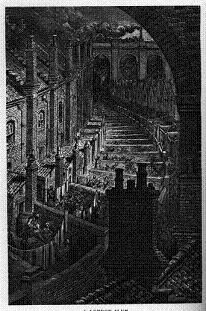- Regency London
Regency London followed the Georgian practice of town-planning along harmonious geometrical lines. However, both the taste of the period and the practical necessities of respecting the layout of existing properties led to the design of curved streets rather than straight ones.
(Note: Regency= early 19th century, when the Prince of Wales, a patron of the arts, was regent for his father King George III who had fits of madness).
The major achievement is Regent Street in London, with the 'Quadrant' curve.
see the website on the history of Regent Street
This led to a perception of the city where surprise would play a part, though the design was formal: a combination of harmony and variety.
See the CATI website, in the section on Fragmented spaces
- Memories of Regency London in later literature and arts
In Dickens's Bleak House (1853), a ridiculous character, Prince Turveydrop, owes his first name to his father's blind admiration for the Prince Regent, and his nostalgia for the age of 'deportment'. These characters live in the new fashionable parts of London (the West).
This well-planned area contrasts with the maze of the Law in the Inns of Court. Regency London is a time-warp in the middle of Victorian London.
